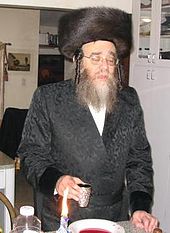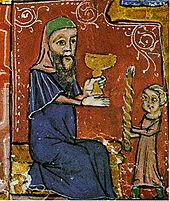Havdalah

Havdalah (Hebrew: הַבְדָּלָה, romanized: haḇdālā, lit. 'separation', Jewish Babylonian Aramaic: אבדלתא, romanized: aḇdāltā) is a Jewish religious ceremony that marks the symbolic end of Shabbat and ushers in the new week. The ritual involves lighting a special candle with several wicks, blessing a cup of wine, and smelling sweet spices (Hebrew: בְּשָׂמִים, romanized: bǝśāmim, lit. '"besamim"', Jewish Babylonian Aramaic: בסמני, romanized: busmē, lit. 'spice, scent').[1] Shabbat ends on Saturday night after the appearance of three stars in the sky.[2]: 137 Havdalah may be performed as late as sunset of the Tuesday following Shabbat.[3] Havdalah is also recited at the conclusion of the biblical holidays.
Customs
[edit]

Like kiddush, havdalah is recited over a cup of kosher wine or grape juice,[4] although other beverages may be used if wine or grape juice are not available.[2]: 141
Spices, called besamim in Hebrew, often stored in an artistically-decorative spice container in order to beautify and honor the mitzvah, are handed around so that everyone can smell the fragrance.[2]: 143 In many Sefardic and Mizrahi communities, branches of aromatic plants are used for this purpose, while Ashkenazi Jews have traditionally used cloves. A special braided havdalah candle with more than one wick[2]: 145 is lit, and a blessing is recited.[2]: 144 If a special havdalah candle is not available, two candles can be used, and the two flames joined when reciting the blessing.[5]
Either right before or right after reciting the words "Barukh atah Adonai Eloheinu melekh ha'olam, bo're m'orei ha'esh," it is customary for the participants to hold their hands up to the candle and gaze at the reflection of the light in their fingernails.[2]: 145 This custom was first recorded in the Or Zarua II (c. 1300).[6]
At the conclusion of Havdalah, some or all of the leftover wine is poured into a small dish and the candle is extinguished in it, as a sign that the candle was lit solely for the mitzvah of Havdalah; some pour directly onto the candle. Based on Psalms 19:9, "the commandment of the Lord is clear, enlightening the eyes," some Jews dip a finger into the leftover wine and touch their eyes or pockets with it. Because it was used for a mitzvah, the wine is considered a "segulah," or good omen.
After the Havdalah ceremony, it is customary to sing "Eliyahu Hanavi" ("Elijah the Prophet") and/or HaMavdil Bein Kodesh LeChol ("Who separates Holy from ordinary/weekday"), and to bless one another with shavua tov (Hebrew) or gute vokh (Yiddish), meaning "Have a good week".
Havdalah is also recited at the conclusion of the following biblical holidays: Rosh Hashanah; Yom Kippur; the first days of Sukkot; Simchat Torah; Passover (Pesach), both its first and last days; and Shavuot. The blessing over the wine is said, as well as the prayer separating the holy from the everyday, but not the prayers over the havdalah candle or the spices (except for the conclusion of Yom Kippur when the prayer over the havdalah candle is recited).
When a major holiday follows Shabbat, the Havdalah service is recited as part of the holiday kiddush and the blessing over spices is not said. The special braided Havdalah candle is not used since it may not be extinguished after the service, but rather the blessing is recited over the festival candles. The prayer "distinguishes holiness from the everyday" is changed to "distinguishes holiness from holiness" signifying that the holiness of the holiday is of a lesser degree than the holiness of the concluded Shabbat. The reason that Shabbat is considered a greater holy day, is because it was the first holy day of the Torah, right in the beginning of it, in the Book of Genesis, corresponding to its historical/dating hierarchy.
Significance
[edit]
Havdalah is intended to require a person to use all five senses: feel the cup, smell the spices, see the flame of the candle, hear the blessings and taste the wine.[7]
Following a normal Shabbat, the order of the prayers corresponds to the acrostic יבנ"ה Yavneh. This acrostic consists of the initials Yayin (wine), Besamim (spices), Ner (candle), and Havdalah (the Havdalah prayer).[4][2]: 140
The order of elements when Havdalah is combined with kiddush (e.g., on a Saturday night that is Yom Tov ("holiday", literally "Good Day") is known by the acrostic יקנה"ז Yaknhaz.[8] This acrostic consists of the initials Yayin (wine), Kiddush HaYom (blessing the day), Ner (candle), Havdala (the Havdala blessing) and Zman (time, i.e. shehechiyanu).
Near the Qaddesh section in some Ashkenazic versions of the Haggadah (e.g. Mantoba 1560, Prague 1526, Venice 1609 and the Goldschmidt Edition),[9]: 80 there is a picture of a hunter chasing a hare.[9]: 80 This picture is a useful mnemonic for the acrostic יקנה"ז Yaknhaz as it can be described by a Yiddish or German sentence that sounds like Yaknhaz. The Yiddish sentence יאָג 'ן האָז yog 'n hoz means "hunt a/the hare!" (cf. Yiddish יאָג דעם האָז yog dem hoz). The colloquial German sentence Jag 'en Has' [jakenhaz] also means "hunt a/the hare!" (cf. German Jag einen/den Hasen!).[9]: 80–81
Blessings
[edit]
The text of the Havdalah service exists in two main forms, Ashkenazic and Sephardic. The introductory verses in the Ashkenazic version (beginning הנה אל, Hinei El)[2]: 140 are taken from the biblical books of Isaiah, Psalms and Esther. In the Sephardic liturgy, the introduction begins with the words ראשון לציון, Rishon L'tsion and consists of biblical verses describing God giving light and success interspersed with later liturgical prose. The four blessings over the wine, spices, candle and praising God for separation between holy and profane are virtually identical between the traditions. The phrase בין ישראל לעמים, bein Yisrael l'amim 'between Israel and the nations' is based on Leviticus 20:26.[10] In Reconstructionist Judaism, however, the phrase is omitted, as part of founder Mordechai Kaplan's rejection of the Biblical idea of chosenness. Modern tunes for Havdalah are based on melodies by Shlomo Carlebach, Neshama Carlebach and Debbie Friedman.
The Ashkenazi liturgy for havdala after a festival or Shabbat is as follows:
| Blessing | Hebrew | Transliteration | English |
|---|---|---|---|
| The following paragraph omitted by most communities at all times other than the conclusion of Shabbat. | |||
| Introductory Verses | הִנֵּה אֵ‑ל יְשׁוּעָתִי, אֶבְטַח וְלֹא אֶפְחָד, כִּי עָזִּי וְזִמְרָת יָ‑הּ ה', וַיְהִי לִי לִישׁוּעָה. וּשְׁאַבְתֶּם מַֽיִם בְּשָׂשׂוֹן, מִמַּעַיְנֵי הַיְשׁוּעָה. לַה' הַיְשׁוּעָה, עַל עַמְּךָ בִרְכָתֶֽךָ סֶּֽלָה. ה' צְבָ‑אוֹת עִמָּֽנוּ, מִשְׂגָּב לָנוּ אֱ-לֹהֵי יַעֲקֹב סֶֽלָה. (ה' צְבָ‑אוֹת, אַשְרֵי אָדָם בֹּטֵֽחַ בָּךְ. ה' הוֹשִֽׁיעָה, הַמֶּֽלֶךְ יַעֲנֵֽנוּ בְיוֹם קָרְאֵֽנוּ.)[11] לַיְּהוּדִים הָיְתָה אוֹרָה וְשִׂמְחָה וְשָׂשׂוֹן וִיקָר. כֵּן תִּהְיֶה לָּֽנוּ. כּוֹס יְשׁוּעוֹת אֶשָּׂא, וּבְשֵׁם ה' אֶקְרָא | Hinei El yeshuati, evtakh velo efkhad, ki ozi v'zimrat Yah, Adonai vayehi li liyeshuah. U'shavtem mayim besasson mima’anei hayeshuah. La’Adonai hayeshuah, al amkha virchatecha, selah. Adonai Tzeva’ot imanu, misgav lanu, Elohay Ya’akov, selah. (Adonai Tzeva’ot, ashrei adam botayakh bakh. Adonai hoshi’ah, hamelekh ya’anaynu veyom karaynu.)[11] Layehudim hayetah orah vesimcha vesason vikar. Kein tehiyeh lanu. Kos yeshuot esa uveshaym Adonai ekrah. | Behold, God is my savior, I will trust God and not be afraid, for my strong faith and song of praise for God will be my salvation. You will draw water joyously from the wellsprings of salvation. Salvation is the God’s; may Your blessing rest upon Your people. God of the heavenly armies is with us; the Lord of Ya’akov is a fortress protecting us. (God of the heavenly armies, happy is the individual who trusts You. God, redeem us! The King will answer us on the day we call God.)[11] The Jews had light, happiness, joy and honor; may we have the same. I will raise the cup of salvation and call out in the name of the God. |
| On wine | בָּרוּךְ אַתָּה ה', אֱ‑לֹהֵינוּ מֶלֶךְ הָעוֹלָם, בּוֹרֵא פְּרִי הַגָּפֶן/הַגֶּפֶן. | Barukh ata Adonai Eloheinu, Melekh ha'olam, bo're p'ri hagafen/hagefen. | Blessed are You, LORD our God, King of the universe, Who creates the fruit of the vine. |
| At the conclusion of Yom Kippur one continues with the blessing on the candle. At all other times except for the conclusion of Shabbat, one continues with the blessing on separation. At the conclusion of Festival coinciding with the conclusion of Shabbat, one does it like the conclusion of Shabbat; however, at the conclusion of Yom Kippur coinciding with the conclusion of Shabbat, customs differ as to whether to make this blessing.[12] | |||
| On spices | בָּרוּךְ אַתָּה ה', אֱ‑לֹהֵינוּ מֶלֶךְ הָעוֹלָם, בּוֹרֵא מִינֵי בְשָׂמִים. | Barukh ata Adonai Eloheinu, melekh ha'olam, bo're minei v'samim. | Blessed are You, LORD our God, King of the universe, Who creates varieties of spices. |
| The spices are then passed around and smelled by those present. | |||
| On the candle | בָּרוּךְ אַתָּה ה' אֱ‑לֹהֵינוּ מֶלֶךְ הָעוֹלָם. בּוֹרֵא מְאוֹרֵי הָאֵשׁ. | Barukh ata Adonai Eloheinu, melekh ha'olam, bo're m'orei ha'esh. | Blessed are You, LORD our God, King of the universe, Who creates the lights of the fire. |
| The candle is held up in the air and those present look at the reflection of the light on their fingernails. According to some customs, this is done immediately before reciting this blessing.[13] | |||
| On separation | בָּרוּךְ אַתָּה ה' אֱ‑לֹהֵינוּ מֶלֶךְ הָעוֹלָם, הַמַּבְדִּיל בֵּין קֹדֶשׁ לְחוֹל, בֵּין אוֹר לְחשֶׁךְ, בֵּין יִשְׂרָאֵל לָעַמִּים, בֵּין יוֹם הַשְּׁבִיעִי לְשֵׁשֶׁת יְמֵי הַמַּעֲשֶׂה: בָּרוּךְ אַתָּה ה', הַמַבְדִּיל בֵּין קֹדֶשׁ לְחוֹל: | Barukh ata Adonai Eloheinu, melekh ha'olam, ha'mavdil bein kodesh l'hol, bein or l'hoshekh, bein yisra'el la'amim, bein yom ha'sh'vi'i l'sheshet y'mei ha'ma'a'se. Barukh ata Adonai, ha'mavdil bein kodesh l'hol. | Blessed are You, LORD our God, King of the universe, Who distinguishes between the sacred and the secular, between light and dark, between Israel and the nations, between the seventh day and the six days of labor. Blessed are You, LORD, Who distinguishes between the sacred and the secular. |
| The person who recited the blessings now drinks the wine. | |||
See also
[edit]References
[edit]- ^ "Havdalah: The Ritual". Archived from the original on 2 June 2013. Retrieved 6 October 2018.
- ^ a b c d e f g h Aruch, Shulchan; Chayim, Orach. Mishnah Berurah - Sefer 3 - Part Two: Law of Shabbos (in Hebrew). Retrieved 6 October 2018.
- ^ "Havdalah - Halachipedia". halachipedia.com. Retrieved 28 December 2020.
- ^ a b "Parashat Toldot". Jerusalem, Israel: Shema Yisrael Torah Network. 2005. Retrieved 6 October 2018.
- ^ Silberberg, Naftali. "The Incense (Besamim) and Havdalah Candle". Retrieved 6 October 2018.
- ^ f. 53v
- ^ "Glossary". Torah.net. Archived from the original on 12 March 2012. Retrieved 6 October 2018.
Ritual ceremony marking the end of the Sabbath and the separation between the sacred and the profane. All the senses are used in blessing the wine, the light of a special candle and smelling spices.
- ^ "Klau Library, Cincinnati Illuminated Haggadah Exhibit". Retrieved 6 October 2018.
- ^ a b c Zuckermann, Ghil'ad (2003), Language Contact and Lexical Enrichment in Israeli Hebrew. Palgrave Macmillan. ISBN 9781403917232 / ISBN 9781403938695 [1]
- ^ Rashbam on Pesahim Pesachim 104a (in Hebrew). Retrieved 6 October 2018.
- ^ a b c The two verses in parentheses appear in most modern Ashkenazic siddurim, but they do not appear in most Siddurim before the 19th century.
- ^ Shulchan Aruch OC 624:3 and commentaries.
- ^ Shulchan Aruch Oc 298:3 and commentaries.


 French
French Deutsch
Deutsch